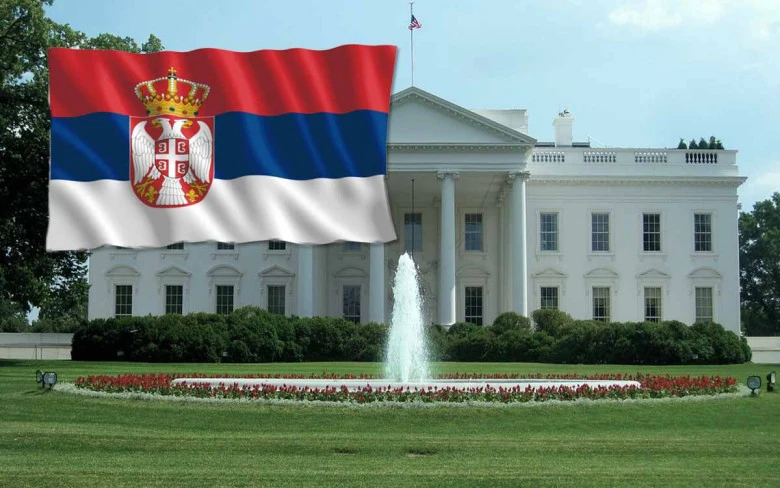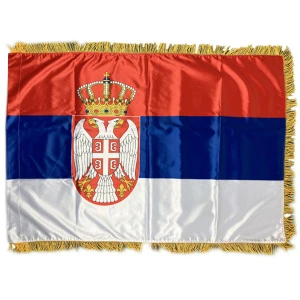- Home
- Blog
- Serbia online
- WHEN THE SERBIAN FLAG WAS FLAGING AT THE WHITE HOUSE
WHEN THE SERBIAN FLAG WAS FLAGING AT THE WHITE HOUSE

In addition to great losses for the whole world, the First World War gave birth to a strong alliance and great solidarity between the United States and one small country in the Balkans. In the overall relations between Serbia and the United States, since the beginning of the Great War, one day will remain especially marked in the history of relations between these two countries.
It was July 28, 1918. It was then that the United States marked four years since the beginning of the Great War, and when the Serbian flag was flown for the first time at the White House, as a sign of respect for the heroic fight and respect for numerous Serbian victims.
Alliance in action
As early as the beginning of 1915, the American medical mission against the typhus epidemic was engaged on the territory of Serbia. After the withdrawal of the Serbian army through Albania, the American Red Cross was especially committed to helping the population in occupied Serbia.
American citizens did not hide their sympathy and support for the Serbian people, although the United States was neutral until 1917. From 1914 to 1916, huge amounts of money and thousands of tons of humanitarian aid arrived to Serbian citizens from the United States.
In that period, there are really many examples of solidarity of American citizens to Serbia, from US President Theodore Roosevelt, who was the first to point out that Serbia was the first to receive an "iron blow", to nurse Agnes Gardner.
The importance and position of Serbia in the First World War was recognized by the wider American public, but also by the then president, Woodrow Wilson, as well as the Secretary of State, Robert Lansing. The United States marked July 28, 1918, as "Serbian Day."
The idea of displaying a flag
The idea of marking the "Serbian day" came from the then Serbian ambassador to the USA, Ljubomir Mihailović, as evidenced by his correspondence with another assistant state secretary, William Phillips.
Namely, on June 1, 1918, Mihailović sent this proposal in a letter to Phillips, in which he explained that "July 28 is the date when the Central Powers declared war on the civilized world", and Phillips replied five days later, saying that he was president impressed by the proposal related to July 28.
It is believed that the positive attitude of the American president towards Serbs was influenced by his acquaintance with the great scientist Mikhail Pupin, who was his personal friend, and at that time he was a world-renowned scientist who lived and worked in the USA.
Serbian flag on the White House
Impressed by the heroism of the Serbian people, the then President of the United States of America, Thomas Woodrow Wilson, declared the "Serbian Day" in Washington on July 28, 1918, on the fourth anniversary of the declaration of war on Serbia. On that occasion, the Serbian tricolor was flying at all institutions, led by the White House.
It is especially important to emphasize the great friendship of the President of the USA, Dr. Woodrow Wilson, with our scientist and Honorary Consul of Serbia in the USA, Mihajlo Pupin, whose selfless work provided a large number of volunteers and huge logistical and military assistance.
Only a month before the Serbian flag was hoisted at the White House and before the above-mentioned touching and strong messages of the President, June 28, 1918, was marked in the United States as a great Serbian holiday - Kosovo Day. The American press enthusiastically wrote about the whole series of manifestations that were organized during June 1918.
In that wave of support for Serbia and the Serbian people in the United States, Secretary of State Robert Lansing played an important role. With tragic and heroic losses with committed principles of freedom and truth, the Serbian army has confirmed its love for its country in the original way. That is why Robert Lansing stated: "One day, when the history of this war is being written, its most famous chapter will be called Serbia."
Interesting fact:
A century after the Serbian flag fluttered on the roof of the White House, on July 28, 2018, a ceremony was held in the US House of Representatives, at which the centenary of the event was marked. On the same day, the former US ambassador to Serbia, Kyle Scott, hoisted the Serbian flag at his Belgrade residence.
Related products
Read also
Who was Saint Sava and what was his contribution?
"Saint Sava: A Beloved Serbian Saint with a Rich Legacy and Cultural Significance"
…Serbian New Year: Tradition, Customs and How to Celebrate it
The Serbian New Year, also known as the Orthodox New Year, is celebrated on…
Gifts Inspired by Serbian Culture: Authentic Ideas for the Holidays
The holidays are a time of giving, and finding the perfect gift is often a challenge.…
Traditional Serbian Christmas Customs: How to Cultivate Them in Modern Times?
Christmas is the most joyous holiday in Orthodox Christianity, a time when families…
How to Bring the Spirit of Orthodox Tradition into Your Home This Winter?
Winter is the perfect time to bring warmth, togetherness and the spirit of Orthodox…
Serbian Souvenirs: Perfect New Year's Gifts for All Tastes
New Year is the time of giving, and what is more beautiful than a gift that…
How to stay productive and not waste an entire day on Black Friday shopping
Black Friday is a day full of amazing discounts, but it can easily become exhausting…
Folk Beliefs and Customs for Saint Aranđel - Assembly of Holy Angels
Saint Michael the Archangel, who is celebrated…
Folk Beliefs and Customs for Đurđić - Glory of St. George
Đurđić, the feast of St. George, celebrated on November 16, is one of the most…
Smart shopper's guide: How to make the most of Black Friday
Black Friday is the most famous shopping event of the year that offers huge…
The history of Black Friday: How it all began and why it continues
Black Friday, known as the biggest discount day of the year, today attracts…
Gifts for Children in the Diaspora: How to Nurture the Connection with the Language, Culture and Tradition of Serbia
Children who grow up in the diaspora face specific challenges - they lose contact…

Apply for newsletter
Sign up for the Serbianshop newsletter and get a 10% discount.















